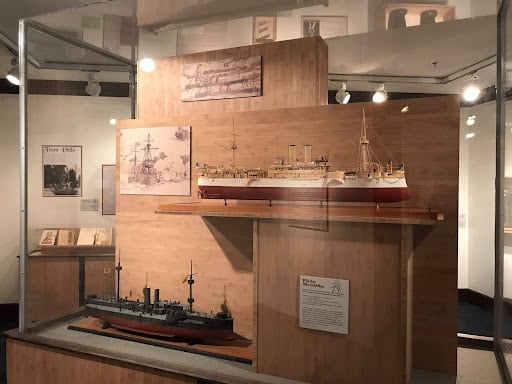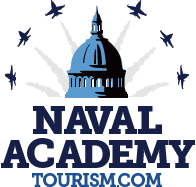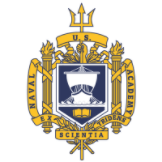The U.S. Naval Academy (USNA) isn’t just a prestigious institution preparing over 4,400 midshipmen for future leadership in the Navy and Marine Corps. It’s also a living, breathing monument to history. From its founding date of 1845, to the legendary figures who have walked its halls, the Yard is steeped in incredible stories of bravery, innovation, and sacrifice.
For history buffs, the Naval Academy is a treasure trove of fascinating landmarks to explore. While visiting every nook and cranny would take a lifetime, a few spots stand out as must-sees for anyone eager to soak in the vast history of this storied place. If you’re seeking fascinating stuff to do in Annapolis, you’ll love visiting the Naval Academy. Whether you’re on a guided USNA tour, or wandering the Yard on your own, these three places promise an unforgettable journey through time.
1. U.S. Naval Academy Cemetery and Columbarium
Situated on a serene hill with breathtaking views of the Severn River and Chesapeake Bay, the 6.7-acre U.S. Naval Academy Cemetery is only one of several active college campus cemeteries. It is more than a peaceful resting place - it’s a site brimming with stories of heroism and sacrifice. Over 5,600 individuals are interred here, including some of the most iconic figures in USNA history.
One standout is Charles A. Zimmerman, the Naval Academy’s longtime bandmaster and composer of the beloved fight song, “Anchors Aweigh.” His grave, marked by a large cross, reflects the deep affection held for him by midshipmen from the Classes of 1916 and 1917, who erected it in his honor.
Nearby, you’ll find the resting place of Admiral James B. Stockdale, Class of 1947. A Medal of Honor recipient and Vietnam War POW who spent over seven years in the infamous Hanoi Hilton, Stockdale’s legacy of resilience and leadership lives on at the Academy’s Stockdale Center for Ethical Leadership.
Don’t miss the gravesite of Senator John S. McCain III, Class of 1958, another POW hero whose distinguished career as an Arizona senator and presidential candidate left an indelible mark on our nation.
The Cemetery is also home to the USS Jeannette Memorial, a striking monument commemorating the ill-fated 1879 Arctic expedition led by Lieutenant Commander George Washington DeLong. Trapped in ice for 21 months, the crew’s harrowing journey and ultimate sacrifices are immortalized in this monument - a haunting reminder of the bravery that defines naval history.
Related: USNA Tours: Visit the Yard Cemetery This Halloween Season
2. U.S. Naval Academy Museum
Nestled in Preble Hall, the Naval Academy Museum is a history buff’s paradise. With two floors (or “decks,” in Navy terms) packed with thousands of artifacts, this museum offers a glimpse into the history of the United States Navy and the Naval Academy itself.
Start your journey with the Revolutionary War collection, where you’ll find treasures like John Paul Jones’s solid gold presentation sword - a gift from French royalty to one of America’s first naval heroes.
Move on to the famed “Don’t Give Up the Ship” flag, proudly displayed as a symbol of resilience and determination. The museum also boasts bone ship models crafted by Napoleonic prisoners of war, artifacts from World War II, and even a moon rock paired with space exploration memorabilia!
The Malcolm Storer Naval Medals Collection is another highlight, featuring over 1,000 medals and coins spanning from 254 BC to the 20th century. This collection showcases the global impact of naval power throughout history.
Best of all? Admission is free, making this treasure trove of history accessible to everyone.
3. Herndon Monument
Standing at just 21 feet tall, the Herndon Monument might seem unassuming at first glance. But for the plebe class each year, it represents the pinnacle of their transformation into Midshipmen, Fourth Class.
During Commissioning Week in May, plebes take on the challenge of climbing the obelisk to replace the dixie cup hat at its peak with an upperclassman’s cover. The twist? The monument is slathered in 200 pounds of vegetable shortening, making the climb a true test of teamwork and determination.
While the climb is a modern tradition (it began in 1940, with grease added in 1949), the monument itself honors Commander William Lewis Herndon, a 19th-century naval officer who heroically went down with his ship, the SS Central America, while ensuring the safety of passengers during a hurricane. His courage is immortalized in the inscription: “Forgetful of self, in his death he added a new glory to the annals of the sea.” His selfless heroism is as inspiring as the impressive monument.
Related: USNA Hero Highlight: Commander William Herndon
There’s Always More to Explore
Beyond these three landmarks, the Yard offers countless other historical gems, including Bancroft Hall and the Nimitz Library. Even the starting point for your journey, the Armel-Leftwich Visitor Center, features fascinating exhibits on space exploration, sports history, and the daily life of midshipmen.
Every visit to the Naval Academy is an opportunity to connect with the past while supporting the future. Proceeds from USNA tours, Yard dining, and Yard shopping directly benefit the Brigade of Midshipmen, providing extracurriculars like the arts, music, theater, and club sports - and helping them continue the Academy’s proud legacy of leadership and service.
So whether you’re an avid history buff exploring Annapolis, or just looking for an inspiring day trip, the Yard welcomes you to walk in the footsteps of greatness. Come for the history, stay for the stories, and leave knowing you’ve contributed to the next generation of extraordinary leaders.
-1.png)










